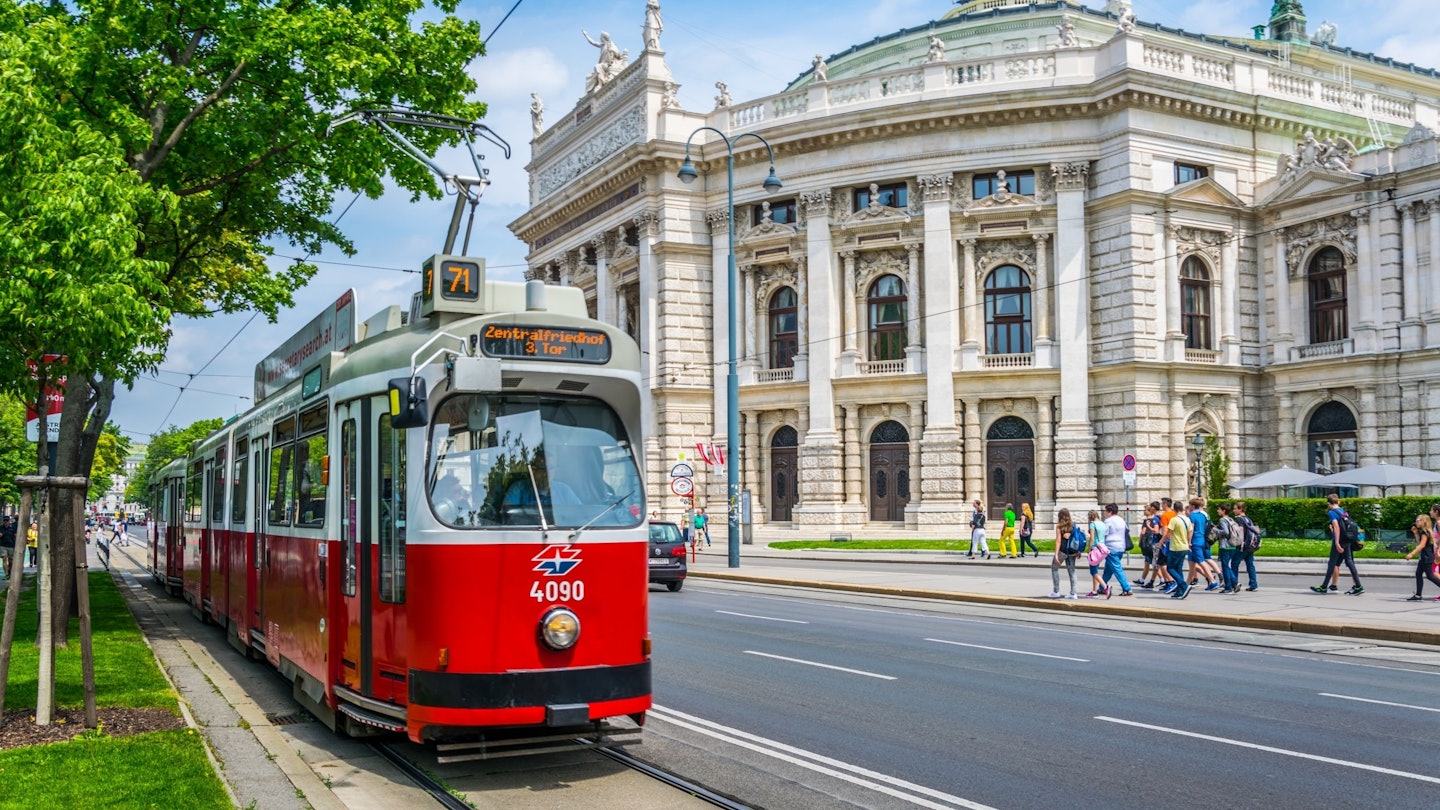

Trams are perhaps the most pleasant (if not the fastest) public-transport option in the Austrian capital ©trabantos/Shutterstock
It’s a pleasure to take in all Vienna has to offer – and there are many ways to travel among all the neighborhoods, palaces, museums and wine bars you’ll find in town.
More laid-back than larger European capitals, Vienna’s famous streets are easy to explore by foot. The Innere Stadt is at the core of the city’s 23 Bezirke (districts), which means you can nose around the site-crammed backstreets and tick off many of the big hitters – from the Hofburg palace to Gothic Stephansdom cathedral – without any vehicle. If you fancy leaping into a bike saddle instead, the paths along banks of the Danube are a cyclist’s dream.
Modern, efficient and reasonably priced, Vienna’s stellar public transport network comes in handy the farther you get from the center: to visit the Prater park, where the Riesenrad Ferris wheel turns; or the baroque palaces of Belvedere and Schönbrunn.
The network is intuitively organized, extensive and operated entirely by Wiener Linien, whose digital hub has all the maps, apps, timetables and tickets you need for getting around without hassle. The network is making great strides on the green front, too, with constant improvements and expansions making public transport far more enticing than driving. A new U5 line with fully automated cars is in the offing, brake energy is used to power some U-Bahn stations, and battery-electric buses and hydrogen-powered buses are set to launch in 2023.
Here are all the ways you can waltz around the Austrian capital.

Vienna by foot
Much of Vienna’s Innere Stadt is pedestrianized, so arrive prepared (and packed) for plenty of walking on cobblestoned backstreets. Exploring on foot truly offers the best sense of this city, allowing you to sidestep the throngs and click into the vibes of its different neighborhoods.
If you’re just in town for a couple of days, you might not need to use public transport at all, as many of the city’s trophy sights, coffee houses, hotels and restaurants cluster in the grand streets of Vienna’s 1st district and along the Ringstrasse boulevard that wraps around it. Pop into Tourist Info Wien on Albertinaplatz for a map to get your bearings.
Beyond the Innere Stadt, as things spread out, you might consider riding public transport between walks. Outside of the iconic 1st district, great neighborhoods to stroll around include the boho-flavored 7th district (Neubau), with its cluster of galleries, cool cafe bars and indie boutiques; the tree-lined avenues of the Prater in the 2nd district (Leopoldstadt); the 13-mile-long (21km) Donauinsel in the 22nd district (Donaustadt); and the artsy lanes fanning north of the foodie Naschmarkt in the 4th district (Wieden).
Vienna by U-Bahn and S-Bahn
On the city’s safe, comfortable and punctual U-Bahn (subway), trains run roughly every five minutes from 5am to midnight Monday to Thursday and Sunday, and 24 hours a day on Friday and Saturday. The U-Bahn gets you close to most sights, especially in the center and denser areas (between the Ringstrasse and Gürtel, for instance).
Tickets are sold at machines (with multilingual instructions), or at windows at stations. Just remember to validate your ticket by slotting it into one of the blue machines before hopping aboard (listen for the click). You only need to do this once if using a day or multi-day pass.
Five lines currently operate: U1 (red), U2 (purple), U3 (orange), U4 (green) and U6 (brown). (U5 is still under construction and is slated for completion in 2025.) All stations have elevators as well as escalators, while platforms have timetable information and signs showing the exits and nearby facilities.
The 10 lines of the S-Bahn run from train stations, servicing suburbs and satellite towns from 4:30am to 1:10am. If you’re traveling outside of the ticket zone of Vienna’s city limits, you’ll probably have to purchase an extension on your standard Vienna transport ticket or buy a ticket from a machine at the station; check on maps posted in train stations.

Vienna by tram
Speed isn’t everything, and something feels gloriously right about trundling on one of Vienna’s 29 tram lines. You’ll need to validate your ticket by stamping it in one of the blue machines when boarding. Trams are either numbered or lettered (eg 1, 2, D) and cover the city center and some suburbs; service runs from 5:15am to 11:45pm. Overall, this mode of transport offers a cost-effective way to see the sights and enjoy a slice of everyday life at the same time.
A tips for exploring by tram: If you only have time for one journey, make it a self-guided spin of the Ringstrasse, which makes for a particularly atmospheric rumble by night, when its monuments are gloriously illuminated.
The Ring Tram caters to tourists, but the (commentary-free) regular service is far less expensive. For the price of a regular ticket, you can take tram 1 heading northwest from Schwedenplatz, changing to tram 2 at Stadiongasse/Parlament, Burgring or Kärntner Ring-Oper to finish at Schwedenplatz.

Vienna by bicycle
Ample green space and the expansive banks of the Danube make Vienna a delight to discover on two wheels. The city is traversed by 870 miles (1400km) of designated, well-marked cycle paths, some passing through little-trafficked areas. The city is geared up for long-distance cyclists, too, as a major stop-off on the Danube Cycle Path, which unfolds over 746 miles (1200km) from Donaueschingen in Germany to Budapest.
You can carry your bike (or e-bike) free of charge on carriages marked with a bike symbol on the S-Bahn and U-Bahn from 9am to 3pm and after 6:30pm Monday to Friday; after 9am Saturday; and all day Sunday.
Tips for exploring by bicycle: The Citybike Wien bike-share scheme comprises 120 bike stands scattered throughout the city. You can register online or with a credit card at any station; simply swipe your card in the machine and follow the multilingual instructions.
The bikes can only be locked up at a bike station (unless you use your own lock). If you fancy something with a bit more oomph, Lime’s fleet of e-scooters is great for zipping about town. Download the app for details on rental locations and rates.
Vienna by bus
Bus connections can be handy for reaching outlying parts of town or for travllers with limited physical mobility. Buses tend to be reliable and punctual, with several very useful routes for visitors, among them 13A (Hauptbahnhof to Alser Strasse); 2A (Schwedenplatz to Schwarzenbergplatz), which covers a substantial chunk of the Innere Stadt; and 3A (Stubentor to Schottenring).
Buy tickets from the driver or a Tabakladen (tobacconist), then validate upon boarding. Most lines run from 5am to midnight, with fewer (sometimes nonexistent) services on weekends. Night buses cover much of the city and run every half-hour from 12:30am to 5am. Schwedenplatz, Schottentor and Kärntner Ring/Oper are stopping points for many night bus services; look for buses and bus stops marked with an “N.” All transport tickets are valid for Nightline services.
Accessible transportation in Vienna
Vienna scores high when it comes to accessible transport, and big plans are in place to make things increasingly barrier-free. Ramps are common, if not universal; most U-Bahn stations have wheelchair lifts and all have guiding strips for the blind. All buses these days have ramps (the driver will assist) and tilt technology, and the vast majority of trams have low-floor access for wheelchairs. Traffic lights have noise cues to indicate when pedestrians can safely cross the road.
Tourist Info Wien’s Accessible Vienna page is a useful resource for the latest accessabilty upgrades.
Transport passes in Vienna
Wiener Linien runs Vienna’s integrated transport network, with a website providing such information as timetables, fares and route planners. A single adult fare (€2.40) covers travel in the core zone in one direction on an uninterrupted journey, including line changes; children under six travel free with a fare-paying adult.
If you plan on getting around a lot by public transport, investing in a travel pass will save you a mint. The most popular options include the day ticket, valid from the start date until 1am (€5.80), and the 24-, 48- and 72-hour passes (€8, €14.10 and €17.10, respectively).
It’s worth bearing in mind that the weekly pass costs the same as the 72-hour one. The 8-day Climate Ticket (€40.80) is ideal if you’re traveling with a group of friends or family and don’t plan on using public transport every day.
Buy tickets at stations, the online ticket shop or by using the Wiener Linien app on your smartphone.
You might also like:
The best museums in Vienna are a curated guide to the city's culture
The best parks in Vienna: 11 glorious green escapes
The best time to visit Vienna: from Christmas markets to film fests
















